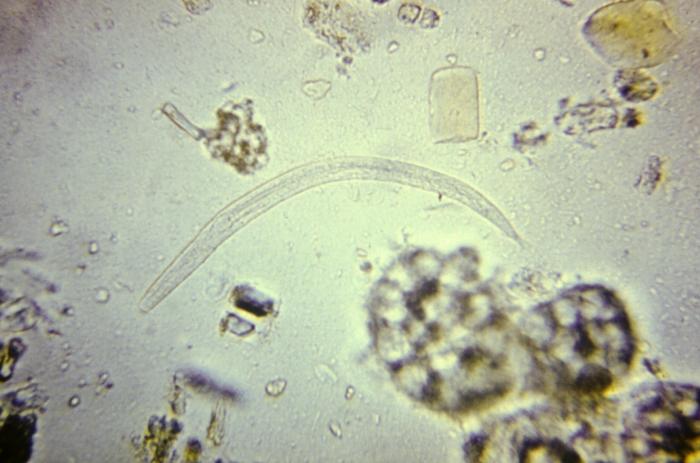UT Southwestern Medical Center researchers have identified a chemical that suppresses the lethal form of a parasitic infection caused by roundworms that affects up to 100 million people and usually causes only mild symptoms.
“The approach we used could be applied generally to any nematode parasite, not just this one type,” said Dr. David Mangelsdorf, Chair of Pharmacology, an Investigator in the prestigious Howard Hughes Medical Institute (HHMI), and one of three corresponding authors of the study published today in the Proceedings of the National Academy of Sciences. The study’s other corresponding authors are at two universities in Philadelphia.

“The plan is to develop better compounds that mimic the Δ7-dafachronic acid used in this study and eventually to treat the host to stop parasitic infection,” he added.
The Centers for Disease Control and Prevention (CDC) reports that the soil-dwelling Strongyloides stercoralis nematode, or roundworm, is the primary strongyloides species that infects humans. Experts estimate that between 30 million and 100 million people are infected worldwide, and most of them are unaware of it because their symptoms are so mild. The parasite can persist for decades in the body because of the nematode’s unique ability to reinfect the host, repeatedly going through the early stages of its life cycle. The nematode that causes the original infection exists in dirt on all continents except Antarctica, and it is most common in warmer regions, particularly remote rural areas in the tropics and subtropics where walking barefoot combined with poor sanitation leads to infection.
Autoinfection and Hyperinfection With Strongyloides Stercoralis
However, in people with compromised immune systems – such as those using long-term steroids for asthma, joint pain, or after an organ transplant – the mild form of the illness can progress to the potentially lethal form, a situation called hyperinfection. Studies indicate that mortality from untreated hyperinfection can be as high as 87 percent.
The World Health Organization reports that although the parasitic illness has almost disappeared in countries where sanitation has improved, children remain especially vulnerable in endemic regions due to their elevated contact with dirt. Further, the drug of choice, ivermectin, is unavailable in some affected countries.
“Ivermectin is used to treat the disease but is less effective in the lethal form of the infection,” said Dr. Mangelsdorf, a Professor of Pharmacology and Biochemistry. “We do not know exactly how the glucocorticoid [steroid] causes hyperinfection, but once it does, ivermectin is much less effective, prompting the search for new drugs. The new drug we used in our mouse model appears to be very effective,” he said.
To study the still unknown pathogenesis of the disease, the researchers developed a mouse model susceptible to the full range of infection by the human parasite. Because mice with intact immune systems are resistant to S. stercoralis infection, the researchers began with an immunocompromised strain of mice, and then exposed some to a synthetic steroid called methylprednisolone (MPA) that is commonly used to treat asthma in humans.
The mice were then exposed to the parasitic worms. Compared with untreated mice, those that received the steroid showed a tenfold increase in the number of parasitic female worms and a 50 percent increase in mortality, said Dr. Mangelsdorf, who holds both the Alfred G. Gilman Distinguished Chair in Pharmacology and the Raymond and Ellen Willie Distinguished Chair in Molecular Neuropharmacology in Honor of Harold B. Crasilneck, Ph.D.
In addition, third-stage larvae – the life cycle stage in which the worms can initiate hyperinfection – were found in higher numbers in the steroid-treated versus untreated mice, he added.
“Strikingly, treatment with a steroid hormone called Δ7-dafachronic acid, a chemical that binds to a parasite nuclear receptor called Ss-DAF-12, significantly reduced the worm burden in MPA-treated mice,” Dr. Mangelsdorf said. The Ss-DAF-12 receptor corresponds to a similar receptor in the long-studied C. elegans worm.
Dr. Mangelsdorf and colleagues previously showed (PNAS, 2009) that the DAF-12 receptor pathway is found in many parasitic species. They also showed that activating the receptor with Δ7-dafachronic acid could override the parasite’s development and prevent S. stercoralis from becoming infectious.
“Overall, this latest study provides a useful mouse model for S. stercoralis autoinfection and opens the possibility of new chemotherapy for hyperinfection by targeting the parasite’s own steroid hormone mechanism,” Dr. Mangelsdorf said.
Related:
- Guinea worm disease: A discussion about the ‘fiery serpent’
- Parasites 101: Ascaris lumbricoides
- Paragonimus: A look at this parasitic lung fluke
- Clonorchis sinensis: The Chinese liver fluke
- Acanthamoeba: A rare and potentially blinding parasite
- Parasites 101: Whipworm
- Dientamoeba fragilis: ‘The unflagellated human flagellate’
- Lymphatic filariasis in Nigeria: The battle against the disfiguring parasitic disease
- Parasites 101: Pinworms
- Parasites 101: Entamoeba histolytica
- Diphyllobothrium: The largest known tapeworms that can infect people
- Parasites 101: Swimmer’s itch
- Parasites 101: Cyclospora
- Coyote tapeworm in Alberta: 5th human case reported
- Raccoon roundworm: The rare and potentially lethal zoonosis
- Outbreak News Radio: Baylisascaris procyonis (raccoon roundworm)
- A Potentially Fatal Parasite First Seen in the Philippines


